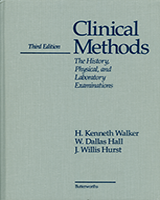From: Chapter 164, The Musculoskeletal Examination

Clinical Methods: The History, Physical, and Laboratory Examinations. 3rd edition.
Walker HK, Hall WD, Hurst JW, editors.
Boston: Butterworths; 1990.
Copyright © 1990, Butterworth Publishers, a division of Reed Publishing.
NCBI Bookshelf. A service of the National Library of Medicine, National Institutes of Health.